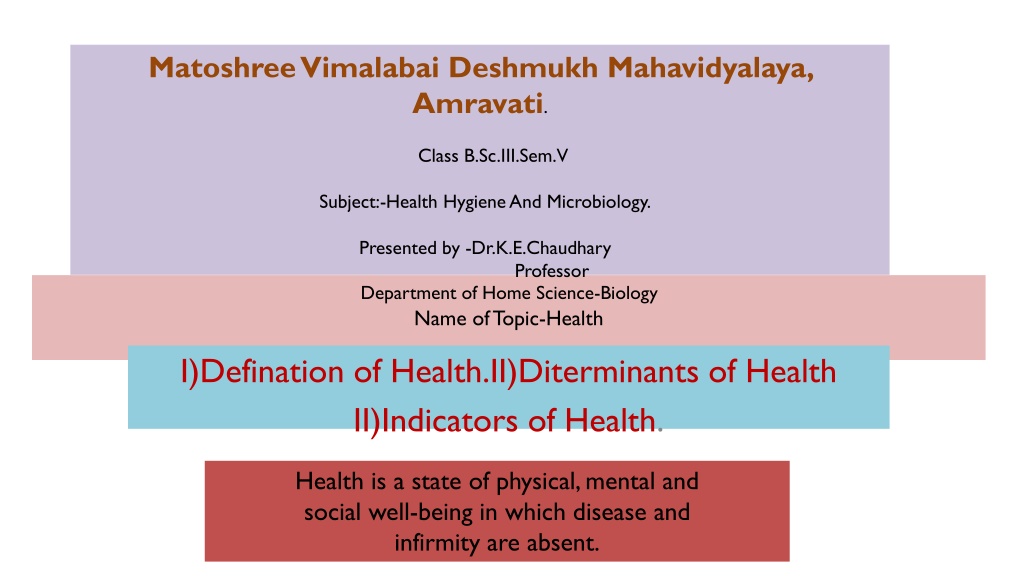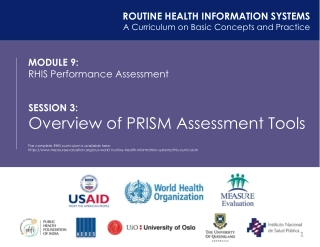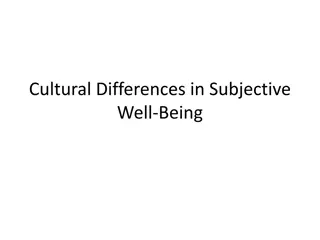Determinants of Health: Understanding Factors Influencing Well-being
Health is a state of physical, mental, and social well-being, free from disease and infirmity. Determinants of health include heredity, environment, lifestyle, and socio-economic conditions. These factors can influence individual and population health outcomes, impacting overall quality of life. Policies, social factors, biology, genetics, lifestyle choices, and economic environments all play a role in determining one's health status.
Download Presentation

Please find below an Image/Link to download the presentation.
The content on the website is provided AS IS for your information and personal use only. It may not be sold, licensed, or shared on other websites without obtaining consent from the author. Download presentation by click this link. If you encounter any issues during the download, it is possible that the publisher has removed the file from their server.
E N D
Presentation Transcript
Matoshree Vimalabai Deshmukh Mahavidyalaya, Amravati. Class B.Sc.III.Sem.V Subject:-Health Hygiene And Microbiology. Presented by -Dr.K.E.Chaudhary Professor Department of Home Science-Biology Name of Topic-Health I)Defination of Health.II)Diterminants of Health II)Indicators of Health. Health is a state of physical, mental and social well-being in which disease and infirmity are absent.
Health is a state of physical, mental and social well-being in which disease and infirmity are absent. II) II)Diterminants Diterminants of health III)Indicators of health III)Indicators of health of health
Determinents of health-1-Heredity 2.- Environment- 3-Life Style 4-Socio economic conditions 1)-Biology and Genetics Some biological and genetic factors affect specific populations more than others. Examples of biological and genetic determinants of health include age, sex, inherited conditions and genetic make-up. 2)The conditions of the environment in which people are born, live, learn, play, work and age. Also known as social determinants of health, they impact a wide range of health, functioning and quality-of-life outcomes. 3)lifestyle-Individual behaviors such as diet, physical activity, alcohol, tobacco and other drug use also play a role in health outcomes.
4)Life style and socio economic conditions Availability of resources to meet daily needs, such as educational and job opportunities, living wages or healthful foods Social norms and attitudes such as discrimination Exposure to crime, violence and social disorder Social support and social interactions Socioeconomic conditions such as concentrated poverty Quality schools Transportation options Urbanisation and the built environment such as buildings or transportation Worksites, schools and recreational settings
Determinants of Health The range of personal, social, economic and environmental factors that influence health status are known as determinants of health. These can be classified as: the social and economic environment, the physical environment, the person s individual characteristics and behaviours. There are many commonly accepted determinants of health but there is no single definition. The Office of Disease Prevention and Health Promotion (ODPHP) has broadly categorised the determinants of health[2]and these have been summarised below: Policy-making Policies at the local, state and federal level affect individual and population health. Increasing taxes on tobacco sales, for example, can improve population health by reducing the number of people using tobacco products. Social Factors Social and physical determinants of health reflect the conditions of the environment in which people are born, live, learn, play, work and age. Also known as social determinants of health, they impact a wide range of health, functioning and quality-of-life outcomes. Examples include:
Examples of Social Determinants Availability of resources to meet daily needs, such as educational and job opportunities, living wages or healthful foods Social norms and attitudes such as discrimination ,Exposure to crime, violence and social disorder ,Social support and social interactions Socioeconomic conditions such as concentrated poverty Quality schools -Transportation options Urbanisation and the built environment such as buildings or transportation,Worksites, schools and recreational settings
Health Services Both access to health services and the quality of health services can impact health. Barriers to accessing health services include lack of availability, high cost, lack of insurance coverage and limited language access. These barriers to accessing health services lead to unmet health needs, delays in receiving appropriate care, inability to get preventive services as well as hospitalizations that could have been prevented. Individual Behaviour Individual behaviors such as diet, physical activity, alcohol, tobacco and other drug use also play a role in health outcomes. Biology and Genetics Some biological and genetic factors affect specific populations more than others. Examples of biological and genetic determinants of health include age, sex, inherited conditions and genetic make-up.
Health Indicators Health indicators are quantifiable characteristics of a population which researchers use as supporting evidence for describing the health of a population. Typically, researchers will use a survey methodology to gather information about certain people, use statistics in an attempt to generalize the information collected to the entire population, and then use the statistical analysis to make a statement about the health of the population. Health indicators are often used by governments to guide health care policy.
Life expectancy may be one of many example of a health indicator is life expectancy. A government might have a system for collecting information on each citizen's age at the time of death. This data about age at death can be used to support statements about the national life expectancy, in which case life expectancy would be a "health indicator" Applications Health indicators are commonly used to guide public health policy A health indicator which will be usedinternationally to describe global health should have the following characteristics: 1. It should be defined in such a waythat it can be measured uniformly internationally. 2 . It must have statistical validity. 3. The indicator must be data which can feasibly be collected. 4. The analysis of the data must result in a recommendation on whichpeople can make changes to improve health List of health indicators. Health indicators are required in order to measure the health status of people and communities.
List of health indicators. Health indicators are required in order to measure the health status of people and communities. Health Indicators Crude death rate Life expectancy Infant mortality rate Maternal mortality rate Proportional mortality rate Morbidity indicators- Prevalence,Incidence,Others Health status-;Incidence counts of any of the following in a population may be health indicators:[3] Low birth weight,ObesityArthritisDiabetesAsthmaHigh blood pressureCancer incidenceChronic pain Oral health,Depression hospital visits due to injury,reports of waterborne diseases or foodborne illness Disability indicators:-Disability adjusted life years (DALY) Others: Activities of daily living (ADL), Musculoskeletal disability (MSD) score etc.

















































